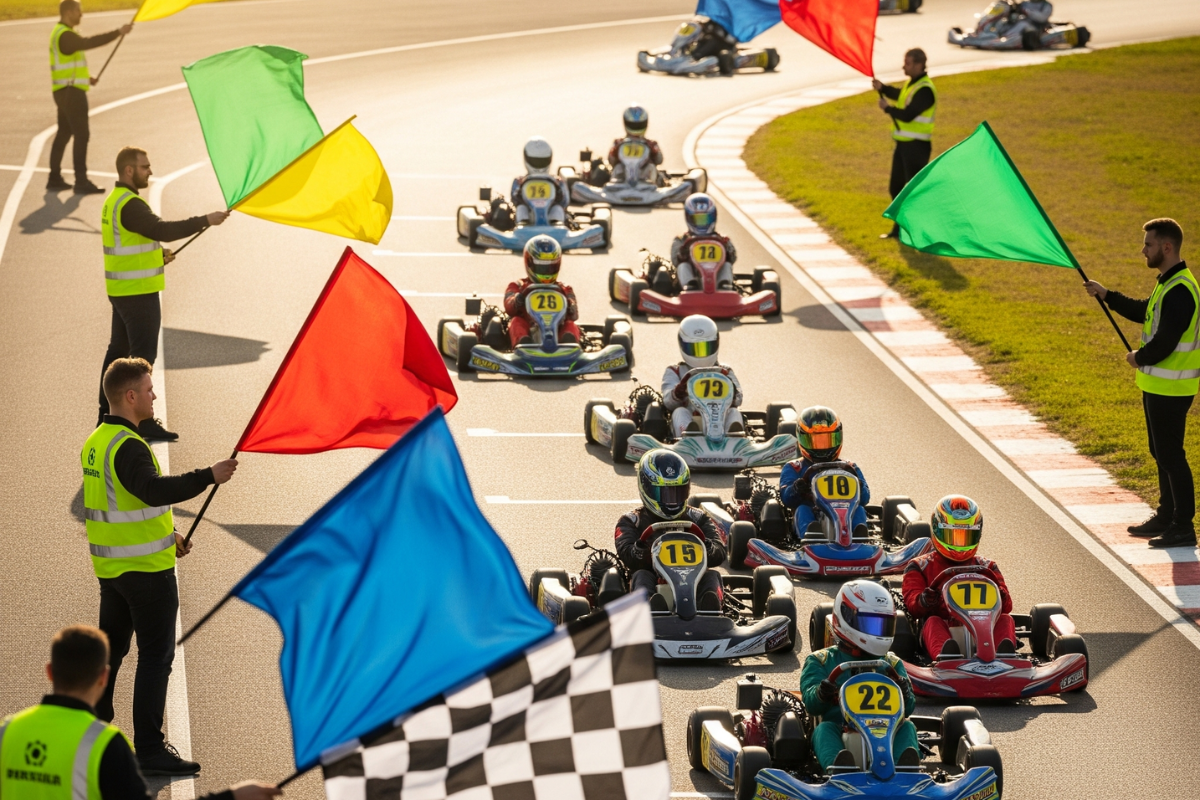Go-karting is a thrilling sport, offering an unparalleled sense of speed and competition. Whether you’re a seasoned racer or a weekend warrior, understanding the nuances of track safety is paramount. It’s not just about pushing the limits of speed; it’s about mastering the environment, respecting the machinery, and, most importantly, ensuring your own safety and the safety of those around you. This comprehensive guide will walk you through the golden rules of karting and demystify the essential flag signals, transforming you from a novice into a track-aware, responsible karter. By internalizing these principles, you’ll not only enhance your enjoyment but also significantly reduce the risks associated with this high-octane sport.
The Unspoken Language of the Track: Flag Signals Explained
The most critical communication system on any karting track isn’t verbal; it’s visual. Flag signals are the universal language used by marshals to convey crucial information to drivers, from immediate hazards to race conditions. Ignoring or misunderstanding these flags can lead to dangerous situations, penalties, or even serious accidents. Learning these signals is non-negotiable for anyone who steps into a kart.
Yellow Flag: Caution! Danger Ahead!
The yellow flag is arguably the most important safety signal on the track. When displayed, it indicates danger ahead or on the track. This could be a spinning kart, debris, an accident, or a slow-moving vehicle.
- Waved Yellow Flag: This means immediate danger in the section you are entering. Slow down significantly, prepare to stop, and be aware of obstacles. No overtaking is allowed under a waved yellow flag.
- Stationary Yellow Flag: This indicates danger further up the track but still within the section. While not as immediate as a waved yellow, it still requires reduced speed and heightened awareness. Overtaking is still prohibited.
- Double Waved Yellow Flags: This is the highest level of caution. It signifies imminent and significant danger, potentially blocking the track. You must slow down to a crawl or be prepared to stop entirely. No overtaking.
Your Action: Immediately reduce speed, maintain your racing line, and be prepared for anything. Do not accelerate or overtake until you have passed the incident or the green flag is shown.
Green Flag: All Clear! Race On!
The green flag is the welcome sight after a caution period or at the start of a race. It signifies that the track is clear, and normal racing conditions have resumed.
- Your Action: When you see the green flag, you can safely accelerate and resume competitive racing, including overtaking.
Red Flag: Stop Immediately!
The red flag is shown in the event of a serious incident that requires the immediate cessation of racing. This could be a major accident, a medical emergency, or a complete blockage of the track.
- Your Action: When a red flag is displayed, you must slow down safely and proceed to a designated safe area or the pits as instructed by marshals. Do not overtake, and be prepared to stop your kart completely. Engine shutdown may be required.
Blue Flag: Move Aside! Faster Kart Approaching!
The blue flag is shown to a slower driver when a faster kart is attempting to lap them. It’s a courtesy flag but should be taken seriously.
- Your Action: If you see a blue flag, you should allow the faster kart to pass safely at the earliest opportunity. Maintain your line but do not make sudden unpredictable moves. This helps maintain race flow and avoids frustration for faster drivers.
Black Flag: Penalty! Return to Pits!
The black flag is a direct command from race control. It indicates that a driver has been disqualified or needs to report to the pits immediately for an infraction (e.g., reckless driving, mechanical issue).
- Your Action: If you see the black flag with your kart number, you must return to the pit lane immediately and safely. Failure to comply can result in further penalties or exclusion from the track.
Black Flag with Orange Circle: Mechanical Issue!
This variation of the black flag indicates that your kart has a mechanical problem that needs immediate attention and is potentially unsafe.
- Your Action: You must return to the pits immediately for inspection or repair.
White Flag: Last Lap!
The white flag signals that the current lap is the final lap of the race or session.
- Your Action: Prepare for the end of the race. Push for a final burst if you wish, but maintain safety protocols.
Checkered Flag: Race Over!
The checkered flag indicates the end of the race or session.
- Your Action: Once you cross the finish line under the checkered flag, slow down safely, maintain your line, and proceed to the designated cool-down area or pits. Do not stop on the track or do victory laps unless specifically instructed.
The Golden Rules of Safe Karting: Beyond the Flags
While understanding flag signals is paramount, safe karting extends to a set of unwritten, yet crucial, golden rules that govern driver behavior and track etiquette. Adhering to these principles not only prevents accidents but also enhances the overall experience for everyone on the track.
1. Always Prioritize Safety Over Speed
This is the overarching rule. No matter how competitive you are, safety should always be your number one priority. Pushing beyond your limits or the kart’s capabilities significantly increases the risk of accidents. Drive within your comfort zone and gradually build up your speed as your skills improve.
2. Attend the Safety Briefing
Before every karting session, whether it’s a recreational rental or a competitive race, there will be a safety briefing. Pay close attention to every detail. These briefings cover specific track rules, emergency procedures, and kart operation specific to that facility. Even if you’re an experienced karter, rules can vary slightly from track to track.
3. Proper Use of Safety Equipment
Ensure all your safety equipment is correctly worn and fitted before you even sit in the kart. This includes your helmet (snug and secured), racing suit (zipped up), gloves, and appropriate footwear. If anything feels uncomfortable or loose, address it before hitting the track. Never drive without proper gear.
4. Maintain Control of Your Kart
Your kart is a powerful machine. Always maintain full control of it. Avoid sudden, erratic movements that could cause you to spin out or collide with others. Smooth, precise inputs are key to both speed and safety. If you lose control, try to steer towards a safe area and be aware of other karts.
5. Respect Other Drivers and Their Space
The track is a shared environment. Treat other drivers with respect and give them space. Intentional contact, aggressive blocking, or reckless overtaking is unacceptable and dangerous. Remember, everyone is there to have fun safely. If you cause an accident, it affects everyone.
6. No Intentional Bumping or Contact
Karting is a non-contact sport. Deliberately bumping or ramming other karts is strictly prohibited and extremely dangerous. Such actions can lead to serious injuries, damage to karts, and immediate disqualification. Focus on clean, skilled driving.
7. Understand and Respect Track Limits
Most tracks have clearly defined track limits, usually marked by white lines or curbs. Stay within these limits. Going off-track can bring dirt onto the racing surface, making it slippery, or put you in a dangerous position where you might re-enter the track unpredictably.
8. Be Aware of Your Surroundings (Situational Awareness)
Always be aware of what’s happening around you on the track. Check your mirrors (if equipped) and periodically glance around to know where other karts are. Anticipate potential hazards and react proactively. This helps you avoid collisions and respond quickly to changing conditions, such as a yellow flag.
9. Smooth and Predictable Driving
Drive in a smooth and predictable manner. Avoid sudden braking, unexpected swerves, or slow driving in fast sections of the track without good reason. Consistent and predictable driving makes it easier for other drivers to anticipate your movements and avoid collisions.
10. Signal Intentions (When Applicable)
While not always explicitly taught, using hand signals (if allowed by track rules and safe to do so) can enhance safety. For example, pointing to the side of the track if you are pulling off due to a mechanical issue can alert others. However, rely more on flags and predictable driving.
11. Return to Pits Safely
When your session or race is over, or if you encounter a mechanical issue, return to the pits safely and slowly. Do not stop on the main racing line unless absolutely necessary for an emergency. Raise your hand if you have a problem to alert marshals.
12. Listen to Marshal Instructions
Track marshals are the guardians of safety. Their instructions are paramount and must be followed without question or hesitation. They have the best vantage point of the entire track and are trained to react to emergencies. Their word is final.
Why These Rules Matter: Beyond the Track
Adhering to these golden rules and understanding flag signals isn’t just about avoiding penalties; it’s about fostering a culture of safety and respect within the karting community. Accidents can be devastating, not just for the individuals involved, but for the reputation of the sport and the enjoyment of all participants. A safe track is a fun track.
By internalizing every aspect of this guide, you equip yourself with the knowledge and discipline needed to truly master the tracks. You’ll become a more confident, skilled, and respected karter, ready to enjoy the thrill of the race while always prioritizing the well-being of yourself and your fellow enthusiasts. So, put on your gear, understand the flags, remember the rules, and get ready for an exhilarating, and above all, safe, karting experience!

Ramon Splinter is a passionate go-kart enthusiast and expert who shares valuable tips and insights on Zyorb, a blog dedicated to karting enthusiasts. With years of experience on the track, he specializes in helping beginners and seasoned drivers improve their skills, optimize their karts, and master racing strategies. His articles combine technical knowledge with practical advice, making go-karting more accessible and exciting for all.

